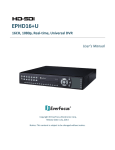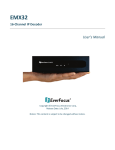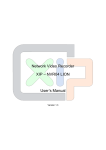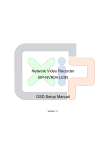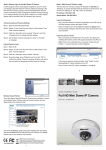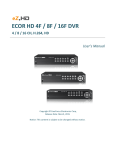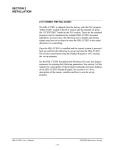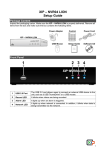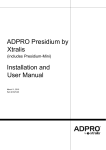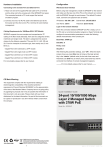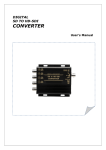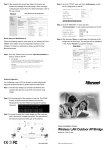Download User Manual
Transcript
SP5736P User’s Manual Caution and Preventive Tips Handle with care, do not drop the unit. Mount the unit in an equipment rack or place it on a solid, stable surface. Indoor use only. Do not place the unit in a humid, dusty, oily, or smoky site. Do not place it in an area with poor ventilation or in an area close to fire or other sources of heat. Doing so may damage the unit as well as cause fire or an electric shock. When cleaning is necessary, shut down the system and unplug the unit from the outlet before uncovering the top cover. Do not use liquid cleaners or aerosol cleaners. Use only a damp cloth for cleaning. Always shut down the system prior connecting or disconnecting accessories, with the exception of USB devices. This symbol intends to alert the user to the presence of important operating and maintenance (servicing) instructions in the literature accompanying the appliance. This symbol intends to alert the user to the presence of unprotected “Dangerous Voltage” within the product’s enclosure that may be strong enough to cause a risk of electric shock. 1 SP5736P User’s Manual Important Information Before proceeding, please read and observe all instructions and warnings in this manual. Retain this manual with the original bill of sale for future reference and, if necessary, warranty service. When unpacking your unit, check for missing or damaged items. If any item is missing, or if damage is evident, DO NOT INSTALL OR OPERATE THIS PRODUCT. Contact your dealer for assistance. WARNING RISK OF EXPLOSION IF THE RTC BATTERY ON THE MAINBOARD IS REPLACED WITH AN INCORRECT TYPE. DISPOSE THE USED BATTERIES ACCORDING TO THE INSTRUCTIONS. 2 SP5736P User’s Manual Table of Contents 1. Overview .......................................................................................................................5 2. System Installation.......................................................................................................6 2.1 Position the Unit .....................................................................................................6 2.2 2.3 2.4 2.5 2.6 Connect Devices to the Unit ...................................................................................6 Front Panel LEDs ...................................................................................................7 Rear Panel Connectors ..........................................................................................8 Basic Setup.......................................................................................................... 11 Basic Playback Operation....................................................................................12 3. General Setup .............................................................................................................15 3.1 USB Mouse Operation..........................................................................................15 3.2 Power On and Login / Logout...............................................................................16 3.3 Function Bar .........................................................................................................16 3.4 Reboot and Shutdown ..........................................................................................20 3.4.1 HDD Auto Scan..........................................................................................20 3.5 System Date/Time Setting ....................................................................................21 3.5.1 Set Date/Time............................................................................................21 3.5.2 Daylight Saving Time Setup.......................................................................22 3.5.3 Network Time Protocol Setup ....................................................................23 3.6 User Management ................................................................................................24 3.7 IP Camera Connection .........................................................................................25 3.7.1 IP Camera Setup .......................................................................................28 3.7.2 Device Setup .............................................................................................30 3.7.3 Event Setup ...............................................................................................31 3.8 Record Schedule/Quality Setting..........................................................................32 3.8.1 Preset Record Configuration .....................................................................32 3.8.2 Schedule Table ..........................................................................................33 3.8.3 Holiday Setup ............................................................................................33 3.8.4 Data Lifetime Setup ...................................................................................34 4. NVR Operation............................................................................................................35 4.1 View Live / Playback Videos.................................................................................35 4.1.1 Viewing Modes ..........................................................................................35 4.1.2 Digital Zoom...............................................................................................36 4.1.3 Playback Recorded Videos........................................................................36 4.1.4 Capture Snapshots ....................................................................................37 4.2 Search Recorded Videos......................................................................................38 4.2.1 Search by Time..........................................................................................38 3 SP5736P User’s Manual 4.2.2 Calendar Search........................................................................................39 4.2.3 Search by Event ........................................................................................40 4.3 Video Export.........................................................................................................41 4.3.1 Select the External Device.........................................................................41 4.3.2 Select Video for Exportation ......................................................................42 4.3.3 Format Device ...........................................................................................42 4.4 Dome Control .......................................................................................................43 4.4.1 Dome Controlling Key................................................................................43 4.4.2 Set Preset Points .......................................................................................45 4.4.3 Call Preset Points ......................................................................................45 4.4.4 Run Dome Camera Sequence/Auto Pan/Cruise........................................46 4.5 System Log Exportation .......................................................................................47 5. Remote Monitoring Software.....................................................................................48 5.1 Remote Monitoring System Requirements ...........................................................48 5.2 Software Installation .............................................................................................49 5.2.1 Change Internet Settings ...........................................................................49 5.2.2 Install Remote Monitoring Software ...........................................................52 5.2.2.1 Log in / Log off..............................................................................53 5.2.2.2 Software Upgrades.......................................................................54 5.3 Basic Operation for Monitoring Remotely .............................................................54 5.3.1 View Live Video .........................................................................................55 5.3.1.1 Select Display Mode.....................................................................57 5.3.1.2 Operate Cameras with PTZ Control .............................................57 5.3.1.3 Digital Zoom of Camera Display...................................................58 5.3.1.4 Manually Trigger Relay Output Devices .......................................58 5.3.2 Instant Recording.......................................................................................59 5.3.2.1 Record Video Instantly .................................................................59 5.3.2.2 Playback Instant Recorded Video ................................................59 5.3.3 Playback Video ..........................................................................................59 5.3.3.1 Playback Remote Video ...............................................................60 5.3.3.2 Playback Local *.drv Files ............................................................61 5.3.3.3 Playback Controls ........................................................................61 5.3.4 Verify Digital Signature ..............................................................................62 5.3.5 Search from Event List ..............................................................................62 5.3.6 Take a Snapshot ........................................................................................63 5.3.7 Health Status of HDD.................................................................................63 5.3.8 Normal and Dual Streaming.......................................................................64 5.3.9 Remote Software Upgrade / Reboot / HDD Setting ...................................64 5.3.10 Remote Monitoring Software Troubleshooting ...........................................66 Appendix A: Keyboard Access Sketch ..........................................................................67 4 SP5736P User’s Manual 1. Overview Micronet SP5736P is a 6 Channel High Definition PoE Digital Network Video Recorder supporting 1080P real-time recording, dual streaming and Full HD display. Moreover the 802.3af compliant PoE (Power over Ethernet) built-in switch is able to support Easy Plug and Play automation installation for IP cameras, hence reduce the complex of the installation, making SP5736P the cost-effective recording systems. With local display output port, the SP5736P NVR offers users Full HD crystal clear video on local monitor without additional devices. Supporting IP cameras dual streaming function and embedded with PoE switch, the SP5736P NVR is a perfect storage allowing system integrators to reduce expenditure on network bandwidth, equipments, camera power supplies, cablings and installations. Just mount your cameras, plug them into the NVR, turn it on, and the system automatically begins recording. It is the smart choice for adding a video security system to your home, business, or office. With compact size casing, the SP5736P NVR allows users to install it in areas with limited space. Moreover, fully remote management and Central Management Software (CMS) are supported to provide distant accessibility for remote system control. Users can also do remote surveillance through mobile devices by using the mobile view application, which can be easily downloaded on the App Store and Google play. 5 SP5736P User’s Manual 2. System Installation The notices and the introduction on system installation will be described particularly in this chapter. Please follow the description to operate the unit. In order to prevent the unit from data loss and system damage caused by a sudden power fluctuation, use of an Uninterruptible Power Supply (UPS) is highly recommended. 2.1 Position the Unit Firstly, note to position/mount the NVR in a proper place and be sure to power off the unit before making any connections. The placed location should avoid hindering or blocking the unit from airflow. Enough airflow is needed to protect the unit from overheating. The maximum allowable temperature of operating environment is 40°C. The unit utilizes heat-conducting techniques to transfer internal heat to the case, especially to the bottom side of the unit. NOTE: Be sure the rubber feet are not removed, and always leave a space for air ventilation on the unit’s bottom side. 2.2 Connect Devices to the Unit This section lists some notices that should be given before making any connections to the NVR. Connecting Required Devices Before powering on the unit, a USB mouse, internet connection, and a main monitor must be connected to the unit for basic operation. Aside from the devices mentioned previously, Pro models also need to connect IP cameras. Connecting Short-term Device If any short-term devices shall be installed to the NVR as a part of the unit system, such as USB ThumbDrive® or any USB devices, etc., make sure those devices are connected only after the unit is powered on. The reason is that the NVR can recognize the external devices only after the power-on process is done completely. 6 SP5736P User’s Manual 2.3 Front Panel LEDs The LEDs on the front panel of the NVR are described as follow. 7 SP5736P User’s Manual 2.4 Rear Panel Connectors There are various connectors on the rear panel for the NVR installations. The connectors are described as the followings. USB Connectors The USB connectors are provided for users to connect external USB devices to the unit, such as ThumbDrive®, or a USB mouse. One of them is for USB 2.0 only that cannot connect the mouse or the keyboard. HDMI The HDMI connector is for connection to an HDMI monitor that transmits data digitally to deliver the best display quality. Alarm I/O & RS485 The unit provides alarm I/O and RS-485 ports(option) that offer users the flexibility required to connect the unit to the other devices. The definition of pins varies when the NVRs have different channels. Refer to Setup Guide for detailed pin definitions. Pin Definition of Alarm I/O & RS-485: 8 SP5736P User’s Manual Pin Definition Pin Definition 0 Alarm In 1 5 RS485 D+ 1 Alarm In 2 6 RS485 D− 2 Alarm In 3 7 Alarm Out NO 3 Alarm In 4 8 Alarm Out COM 4 Ground 9 Alarm out NC LAN (RJ-45) The NVR is capable of networking and it allows the videos to be viewed over the LAN network or the Internet by using the Internet Explorer. PoE Ports (Pro Models Only) The PoE ports offer direct connections to 6 IP cameras. Note that only Micronet of the IP cameras can be “plug and play”. Power Jack Connect the power supply cord and the power adaptor shipped with the NVR. The power jack is (DC48~52V). NOTE: Use of other power supply cords or power adaptors may cause overloading. 9 SP5736P User’s Manual NOTE: Installer can adjust the DIP switches located on the inner portion of the IC board, ensure you video output for NTSC or PAL standard. NTSC(1,2 up; 3,4 down): PAL(1,2,3 up; 4 down): 10 SP5736P User’s Manual 2.5 Basic Setup A, Basic Setup Enter the OSD main menu to setup some basic configuration of the NVR. The basic configuration can be set via either the NVR or NVRRemote, the remote software. Enter OSD Main Menu: Click on the Menu icon in the Function Bar and select <Menu> to enter the OSD main menu. Date / Time Setting: Follow the steps below to setup date/time before the recording starts. Refer to the User’s Manual for advanced setup of Time Sync function. Select <Date/Time> in System menu. Select date or time, and adjust the value by clicking on the UP/DOWN buttons. The new date and time settings take effect after the changes are confirmed. Language Setting: If users wish to change the language of the NVR system, follow the steps below. Select <Language> in System menu. Click on the DOWN buttons to choose the preferred language. B, Network Setup Configure the LAN setup for the NVR to properly function with Ethernet connection. From OSD main menu, select <System > <Network Setup>, set the <LAN Select> item to <LAN>, and enter <LAN Setup>. For DHCP users, set the DHCP to <ON>. The IP address, Netmask, Gateway and DNS settings are retrieved from network servers. DHCP is dynamic that the settings change from time to time. For Non-DHCP users, set the DHCP to <OFF>. IP address, Netmask, Gateway and DNS settings must be set. Please obtain the information from the network service provider. To change the IP address, Netmask, Gateway and DNS value, click on the <Num> button to display the number pad and input users’ preferred setting values. When the settings are completed, click on the <X> icon on the top-right corner to exit. C, Monitor Mode The NVR provides Standard and Portrait viewing modes in full-screen, 4-windows and 6-windows layouts. Refer to the following for operations how to change viewing modes. Click on the Monitor Mode icon in the function bar to change between Standard or 11 SP5736P User’s Manual Portrait modes. Click on MODE repeatedly to select a preferred display layout. Refer to the User’s Manual for more detail. 2.6 Basic Playback Operation Search By Time: Click on the Search icon in the Function Bar to enter the Search menu. Click on “From” and playback will start from the specified “From” time. Click on “End” and playback will start from the specified “End” time. Click on “Select” and choose date or time. Click on the UP/DOWN buttons to adjust the values. Click on <Begin Playback> to start playing back recorded video of the selected time. NOTE: If no available recorded video matches the specified time and date, the unit starts to playback from the next available video. Calendar Search: Click on the Search icon in the Function Bar to enter the Search menu. Click on <Calendar Search> and a calendar will show up. Select any date shown in underlined font, which means recording data are available. The table shown on the left will display available videos of each channel within the selected date. The videos are classified into four categories: Normal, Motion, Alarm In and Video Loss, shown as four different tabs on the top. Then select a preferred time from the time bar. Alternatively, specify the values of date/ hour/ minute/ second under <Select> on the right. The video preview windows will playback previews of the selected time. Users can click on the preview window to instant playback the video. The <From> and <End> buttons allow users to playback video from the beginning or end of the database. Click on <Begin Playback> to start playing back the selected video. Search by Event: Click on the Search icon in the Function Bar to enter the Search menu. Adjust date / time next to <From> and <End> under <Search By Event> to specify time range of the event search. Select the channels and/or event types to be filtered in the event search. 12 SP5736P User’s Manual Click on <Event List> to list the event video of the selected channels. The list displays each event by date, time, triggered camera and event type. The latest recorded event video will be listed on the top. Click on the <X> icon on the top-right corner to exit. Click on the buttons at below to see the previous or next pages of the Event List. Click on the selected event record to playback the event video. NOTE: The event list displays only the first 1024 events; as some events are deleted, others are displayed. Playback Controls of Control Panel Buttons: Icon Description Icon Description Time Frame of the Previous Day Time Frame of the Next Day Backward Playback: Click repeatedly to increase speed by 1×, 2×, 4×, 8×, 16×, or 32×. When the playback is paused, click on this icon to do Step Backward. Forward Playback: Click repeatedly to increase speed by 1×, 2×, 4×, 8×, 16×, or 32×. When the playback is paused, click on this icon to do Step Forward. Pause Playback Change Viewing Mode Search Menu Return to Live Mode System Info The System Info page will be shown as below. There are mainly three parts: the brief info of IP cameras at top-left, the connection status of IP cameras at top-right, and the brief system info at the bottom. Users can click on any IP camera icon at top-right to show its brief info at top-left. 13 SP5736P User’s Manual The link to IP camera icons will be displayed in four different colors. Green: This indicates good connection to the IP camera. Red: This represent the connection to the IP camera is failed. Blue: This means the NVR is trying to connect to the IP camera. Grey: There is no IP camera setup for the channel. Click on the CLOSE button to exit the System Info page. 14 SP5736P User’s Manual 3. General Setup Before operating the NVR, some general configuration should be setup first. The following subsections will introduce general configuration of the NVR. The regular displayed OSD information and its displayed positions are shown as the following figure. Title of the channel will be displayed on the top-center of the gird, either in full-screen mode or in multiple channel mode. The current operation status and date/time information will be displayed in the status bar at the bottom of the screen. Move the cursor to any status bar icon and its description will be displayed. Refer to the Setup Guide for a list of status bar icons and their descriptions. CH1 CH2 CH3 CH4 CH5 CH6 2013/05/09 04:31:22 PM 3.1 USB Mouse Operation A USB mouse must be connected in order to operate the NVR. As shown in the figure on the right, click the left button to select or “ENTER”. Conversely, click the right button to exit or “ESC”. The scroll wheel is for adjusting values. In addition, users can also connect a USB keyboard to help operating the NVR. Refer to the appendix for key definition of the USB keyboard. 15 SP5736P User’s Manual 3.2 Power On and Login / Logout After all required devices are connected, plug in the power adaptor with the power supply cord to power on the NVR. Make sure the power source is between AC 110V to AC 240V. Once the NVR is powered on, the login page will be displayed. Users can choose to login with two preset accounts: “admin” and “user”. The preset password for the administrator account “admin” is “1234”, while the preset password for the “user” account is “4321”. NOTE: It is strongly suggested to change the preset password to prevent unauthorized access to the unit. An icon displayed at the status bar will show the authority level of the account. Under logout condition, the icon will be a guest icon. When an account is logged in, its privilege level number (1~8) will be shown. While an account is logged in, users can access functions to set to the equivalent or lower authority level. To logout the system, click on the Menu icon at the left of the function bar and select <Logout>. Refer to the following section for more details about the function bar. 3.3 Function Bar The function bar located at the bottom of the screen allows users to setup and operate the NVR with the intuitive GUI experience. On the function bar, icons from left to right are Menu icon, Status icons, Mode icon, Search icon, PTZ Control icon, Playback icon, Monitor Mode icon, System Info icon, Camera Setup icon and Date/Time Information. The System Info icon will only be shown after an authorized account is logged in. NOTE: Users can also right click the mouse, and the pop-up menu provides some similar functions such as Mode List, Mode, Search, Dome and Fast PB. The Function Bar will be displayed at the bottom and the functional icons are 16 SP5736P User’s Manual listed as below. Item Icon Description Item 1 Menu 2 3 Icon Description Item 4 PTZ Control 7 Mode 5 Playback 8 Search 6 Icon Description System Info Camera Setup Monitor Mode Another group of display icons shown on the right of the Menu icon are the status icons. Refer to the following chart for their descriptions. Item Icon Description Item Icon Description 1 Record 9 Disk Error 2 Event Record 10 Disk Full 3 Lock 11 Disk Overheat 4 Zoom 12 No Disk 13 Disk Almost Full 5 Pause @ Playback mode Forward Playback 6 Speed: 14 1x, 2x, HDD Usage 4x, 8x, 16x, 32x Backward Playback 7 Speed: 1x, 2x, 15 User’s Authority Level 4x, 8x, 16x, 32x 8 End of Video 16 Guest NOTE: Items #9~#14 will only be displayed when the circular recording mode is OFF. Menu icon 17 SP5736P User’s Manual Click on this icon and the pull-up list contains <Menu>, <Login>, <Logout> and <Shutdown>. Users can enter the OSD setup menu, login the system, logout the system, and shutdown the NVR. Status icons Several status icons will be displayed here to indicate current NVR system status. Move the cursor to an icon and its description will appear. Please refer to the Setup Guide for a list of all status icons. Mode icon Click on this icon repeatedly to change the viewing mode from 1x1, 2x2 or 3x2 display grids. Refer to section Viewing Modes for more details. Search icon Click on this icon to search for preferred normal or event recorded videos. PTZ Control icon This icon is for users to control PTZ functions of a dome camera. First select a channel, then click on this icon to enter PTZ Control mode. A control panel will be displayed on the screen. A later chapter will explain PTZ Control operation in detail. Playback icon Click on this icon to instant playback the normal recorded videos from last suspended point. Alternatively, the playback will start from the beginning of available time for the first time. Monitor Mode icon The NVR provides two different monitor modes, namely, Standard mode and Portrait mode. Refer to section Viewing Modes for more details. System Info icon Click on this icon to see the system information of the NVR. Camera Setup icon Click on this icon to add IP Cameras to each channel. The device search function is provided for users to quick search for IP Cameras installed in the same LAN. Refer to a later chapter for steps to add IP Cameras. Date/Time Information On the right is the Date/Time information of current system time. Users can 18 SP5736P User’s Manual also choose to hide the Date/Time information by changing the setting in the OSD setup menu. Refer to section System Date/Time Setting for more details. 19 SP5736P User’s Manual 3.4 Reboot and Shutdown If the NVR must be reboot or shutdown for any reason, please follow the proper reboot or shutdown procedures to avoid damaging the NVR. Reboot Click on the Menu icon and select <Menu>. Then enter the <System> menu and find <Reboot> at the bottom. Click on <Reboot> and confirm the pop-up message to reboot the NVR. Shutdown There are two ways to shutdown the NVR. Users can click on the Menu icon and select <Shutdown>. Alternatively, the <Power Off> item under the <System> menu also allows users to safely shutdown the NVR. Do not remove the power source until the NVR is completely off. 3.4.1 HDD Auto Scan When the NVR found file system error while recording, the NVR will reboot and HDD auto scan will be initiated. If by any chance auto scan failed, the HDD will need to be formatted. Read the following troubleshooting to finish the auto scanning process. Skip Auto Scan: During the scanning process, users can press any key to skip the process. Time Expired: When the scanning process took more than predetermined time (3hrs for 1TB HDD, 6hrs for 2TB HDD, etc), the scanning process is treated as failed and will be automatically terminated. The NVR will reboot. Format HDD: If the scanning process failed, users will be prompted to confirm format of the HDD with error. When users confirmed, login of an authorized account is required if password protection is enabled. If users select cancel or do not respond within 5 minutes, the HDD with error will be marked as a NG HDD. A NG HDD will not be counted as a part of the NVR’s database. It will just stay there doing nothing. Recover NG HDD: Enter the OSD setup menu via an authorized account and access <Database>. Then select <Internal Disks> and find the NG HDD from the list. Under <Action> column, select <Format> to format the NG HDD. Then select <Add> to add the formatted HDD to the database. NOTE: The above actions will be recorded in the system log data. 20 SP5736P User’s Manual 3.5 System Date/Time Setting Users can set the current date, time and other OSD parameters in Date/Time menu (under System menu). The login account should have authority to access the System menu. In OSD setup menu, select <System>, and then select <Date/Time> to access the Date/Time menu; the menu displays as follows. Date/Time Date Time Time Zone Date Display Mode Time Display Mode Daylight Saving Time Setup Network Time Protocol Setup 3.5.1 2013/05/07 PM 10:39:26 Off Y/M/D 12 HR Set Date/Time Set Date/Time Select <Date> or <Time> for adjusting the settings. Click at the target position and click on the UP/DOWN arrow buttons or scroll the mouse wheel to change the value in the selected field. NOTE: The new date/time setting applies to videos recorded after the change. The date and time of previously recorded videos will not be altered. NOTE: If time settings have to be changed in any case, it is strongly recommended to format the HDDs to avoid database corruption. Date Display Mode This item allows users to set the OSD display type of the date. There are three options to select from: <Y/M/D>, <M/D/Y> or <D/M/Y>. “Y” represents “Year”, “M” represents “Month” and “D” represents “Day”. Time Display Mode Users can set the time format to <12 HR> or <24 HR>. 21 SP5736P User’s Manual 3.5.2 Daylight Saving Time Setup Daylight Saving Time This is for people who live in certain regions to observe Daylight Saving Time. Select <On> to enable, or <Off> to disable the function. If the function is disabled, the DST Start/End time and DST Bias will be grayed out and cannot be accessed. NOTE: If this function is enabled, the date/time information will be shown on the screen with a DST icon when playing back recorded videos or searching videos in the event list. “S” indicates summer time and “W” indicates wintertime. DST Start/End These items are used to program the daylight saving duration. Click at the target position and click on the UP/DOWN arrow buttons to change the value. DST Bias This item allows users to set the amount of time to move forward from the standard time for daylight saving time. The available options are in minutes. 22 SP5736P User’s Manual 3.5.3 Network Time Protocol Setup Time Zone Select users’ current time zone. Please visit www.greenwichmeantime.com to find out the correct local time zone, or refer to the following figure. NOTE: <Time Zone> must be set to the correct local time zone or <Network Time Protocol Setup> will not be accessible. Network Time Protocol Setup After time zone is selected, <Network Time Protocol Setup> option will be available. Select <Network Time Protocol Setup> to set the NTP server. The default NTP server is time.nist.gov. Users can always change to any other NTP servers. A list of IP addresses of the NTP servers is listed below. 129.6.15.28 132.163.4.102 192.43.244.18 206.246.118.250 207.200.81.113 129.6.15.29 132.163.4.103 131.107.1.10 208.184.49.9 64.236.96.53 132.163.4.101 128.138.140.44 69.25.96.13 64.125.78.85 68.216.79.113 After the time server is set, select <Yes> for <Manually Time Sync> to sync the time immediately. The time sync can also be updated periodically. Select <On> for <Automatically Time Sync>, and the time will be automatically synced once an hour. 23 SP5736P User’s Manual 3.6 User Management The NVR provides the option to create up to seven sets of usernames and passwords with customized privilege level, excluding the preset “admin” account. Enter OSD setup menu, select <System> <User Management> and the menu is as follows. User Management Password Protection Account Setup Permissions Setup Load Default Setting On No Password Protection Select <On> to request for username and password for accessing functions listed in Authority Setup menu, or select <Off> to allow free access. Account Setup Setup customized account, password, and privilege level in this menu. The account is case sensitive. The privilege level rank from level 1~8, and level 8 has highest privilege. Alternatively, select <Disable> to stop using the account. A second password can also be specified, if required. NOTE: The username and privilege level of the preset administrator account “admin” cannot be changed. Permissions Setup Setup the allowed authority level for accessing the functions listed in this menu. In accordance with users’ privilege level defined in <Account Setup>, the authority level here also ranks from levels 1~8, with level 8 as the highest level. Users will be able to access any function that is set to their equivalent level or lower. Alternatively, select <DISABLE> to allow free access. NOTE: The “Menu Access” cannot be set to <Disable>. When the account does not have authority to access certain functions, an error message will be displayed on the screen. Load Default Setting Select <Yes> to load the default setting. 24 SP5736P User’s Manual 3.7 IP Camera Connection Standard models connect IP cameras via Internet. Pro models support PnP function to directly connect IP cameras. If users wish to connect IP cameras to Pro models via Internet, just disable PnP function. The following describes how to connect IP cameras to the NVR via Internet. Click on the Camera Setup icon in the function bar, and the setup page will be shown as below. The setup page below is from Pro models, which includes the item <PnP>. As for Standard models, <PnP> is not included. Set <PnP> of Pro models to <OFF>. Follow the steps below to add IP camera connections for both models. Camera Search Brand ***** ***** ***** IP: 192.168.6.111 Camera Setting PnP ‧CH01 Off ‧CH02 Off ‧CH03 Off ‧CH04 Off ‧CH05 Off ‧CH06 Off CH01 Activate Off Off Off Off Off Off Micronet MAC Address **:**:**:**:**:** **:**:**:**:**:** **:**:**:**:**:** IP Address 192.168.6.111 192.168.6.112 192.168.6.113 Model ***** ***** ***** CH02 Protocol Micronet Micronet Micronet Micronet Micronet Micronet CH03 CH04 CH05 IP Address 192.168.50.*** 192.168.50.*** 192.168.50.*** CH06 More NOTE: For Pro models, the preset of PnP function is <ON>. Items <Activate>, <Protocol>, <IP Address>, and <IP Camera Setup> are grayed out and cannot be accessed. Select the type of IP camera model on the top: Micronet, ONVIF or All. Click on the Search icon at the top-right corner. The NVR will start to look up supported IP cameras installed in the same LAN. Find a target IP camera in the list and click on it. The IP address of the target IP camera will be shown next to <IP: >. Click on a preferred channel button to assign the selected IP camera. Alternatively, users can also click on the IP Address box next to Protocol, and a virtual keyboard will be displayed. User can manually input the IP address. Set <Activate> (next to <Protocol>) to <ON> to activate it. The NVR will 25 SP5736P User’s Manual automatically setup the configuration of the IP camera. Alternatively, before set <Activate> to <ON>, users can manually setup the configuration of the IP camera by clicking on the IP Camera Setup icon next to the IP address. Refer to the subsection for details about manual setup. Click on the Device Setup icon. Users can directly configure the settings of the IP Camera, even <Activate> is not set to <ON>. Note that Device Setup is ONLY available for Micronet. Refer to subsection for more information. Click on the Event Setup icon at the right of Camera Setting, and users can configure event settings of each channel. Refer to subsection for more details about Event Setup. Repeat the steps above to connect up to six channels of IP cameras. IP Camera Setup via Plug and Play Connection: Please follow the steps below to configure IP cameras connected to the NVR via PoE ports. Click on the Camera Setup icon in the function bar and the following menu will be displayed. Camera Search Brand ***** ***** ***** Model ***** ***** ***** IP: 192.168.6.111 Camera Setting PnP ‧CH01 On ‧CH02 On ‧CH03 On ‧CH04 On ‧CH05 On ‧CH06 On IP Address 192.168.6.111 192.168.6.112 192.168.6.113 CH01 Activate Off Off Off Off Off Off Protocol CH02 CH03 MICRONET Series MAC Address **:**:**:**:**:** **:**:**:**:**:** **:**:**:**:**:** CH04 CH05 IP Address CH06 More MICRONET Series 192.168.50.*** MICRONET Series 192.168.50.*** MICRONET Series 192.168.50.*** MICRONET Series MICRONET Series MICRONET Series Click on Device Setup icon < >. Users can directly configure the settings of the IP Camera. Note that Device Setup is ONLY available for Micronet Series. Click on Event Setup icon < > at the right of Camera Setting. Users can configure event setting of each channel. Four event types, <Vloss>, <Motion>, <AlmIn> and <AlmOut>, are included in Event Setup. Note that <AlmIn> and <AlmOut> ONLY support CH1~CH4. NOTE: For more details about Device Setup, please refer to User’s Manual. IP Camera Setup via Internet Connection: 26 SP5736P User’s Manual If users need to connect and setup IP cameras via network, please follow the steps below. First select the type of IP camera model on the top-right. Click on Search icon < > at the top-right corner. The NVR will search the selected models in the same LAN. Under PnP, switch <On> to <Off> at the preferred channel. Click on a preferred IP camera in the list. Then click on the channel button whose PnP function is <Off>. Under Activate, switch <Off> to <On> at the selected channel. The NVR will begin to connect the selected IP camera. If users need to configure the advanced setup, click on IP Camera Setup icon < > before activating the IP camera. To further configure Device Setup and Event Setup, users can refer to the steps from previous subsection. NOTE: For more details about IP Camera Setup and Device Setup, please refer to User’s Manual. Indication Icons of Connection Status: The indication icons are next to the channels at camera setting. Users can see the connection status of IP cameras while setting up the IP cameras. Ico n ‧ ‧ Description Successful Connection No IP camera setup for the channel Ico n Description ‧ Connecting IP Camera ‧ Failed Connection Status Icons of IP Camera: The table below describes the connection status of IP camera at Live mode. Ico n Description Ico n Description Connecting IP Camera Successful Connection Failed Connection Resolution Oversize No Connection 27 SP5736P User’s Manual 3.7.1 IP Camera Setup The IP Camera Setup menu is show as below. IP Camera Setup Account Password Management Port Main Stream Setup Dual Stream Setup IP Dome Protocol IP Dome ID Admin **** 80 None 0 Account/Password Access these two items to enter a valid account name and password of the connected IP camera. Management Port Access this item to enter the default port of the IP camera. 28 SP5736P User’s Manual Main Stream Setup Under this menu, users can setup configuration for the main stream. The streaming format will be <H264>. If users wish to setup streaming index, port and protocol manually, set <Advance Streaming Options> to <On> and select preferred values for the corresponding menu items. Main Stream Setup Streaming Format Advance Streaming Options Streaming Index Streaming Port Streaming Protocol H264 Off Stream1 554 RTP+RTSP Dual Stream Setup Under this menu, users can setup configuration for the dual stream. First set <Dual Streaming Support> to <Yes> and continue the rest of the setting. If users wish to record the dual stream, choose <Yes> next to <Dual Streaming Recording>. The remaining items are the same as in <Main Stream Setup>. The streaming format will be <H264>. If users will setup streaming index, port, and protocol manually, set <Adv. Dual Streaming Options> to <On> and select preferred values for the corresponding menu items. Dual Stream Setup Dual Streaming Support Dual Streaming Recording Dual Streaming Format Adv. Dual Streaming Options Dual Streaming Index Dual Streaming Port Dual Streaming Protocol Yes Yes H264 Off Stream2 554 RTP+RTSP IP Dome Protocol/IP Dome ID If the connected device is an IP Dome Camera, then select an appropriate IP Dome Protocol from the provided options and setup its Dome ID. 29 SP5736P User’s Manual 3.7.2 Device Setup Enter Device Setup menu to configure three main settings of IP cameras, <Image>, <Video Format> and <Motion>. Image Users can configure the image settings of the IP camera. The image settings include image adjustment, noise reduction, white balance, etc. When users are adjusting image configuration, users can watch the viewing window at the right to check the change of image setting in the mean time. Video Format In <Video Format> tab, users can configure the settings of video format. The video format settings include video resolution, video rotate, H.264 profile and CBR/VBR mode. Besides, users can also set factory default or reboot the IP camera. Model ID and firmware version can be checked in this tab. Motion Users can setup the configuration of motion detection in this tab. Motion detection settings include sampling, detection level, sensitivity, time interval and motion window. The following is the description of each item. Sampling: This item is used to examine the differences between two frames. Users can configure the interval of sampling pixel. For instance, if users set the interval as 5. IP camera system will take one sampling pixel from every 5 pixels of each row and each column in detection area. The alarm will be triggered when differences are detected. Detection Level: Users can configure detection level for each sampling pixel. Detection level is how much the dome camera can accept the differences between two sampling pixels. The smaller the value is, the lower the detection level. Sensitivity: This item is used to set the detection sensitivity. A greater value indicates higher sensitive motion detection. 30 SP5736P User’s Manual Time Interval: This item is for users to adjust the value of the time interval between each detected motion. Motion Window: This item is used to set detection areas, and each IP camera might provide different amount of detection areas. Follow steps below to select the detection area. First, select a number next to <Motion Window>. Click and drag the mouse to choose the area users wish to set as the detection area. The number that users previously chose will show in the middle of the selected area. Lastly, click on <Apply> button to save the setting. Repeat the above steps to set other detection areas. 3.7.3 Event Setup Enter Event Setup menu to configure event settings for each selected IP camera. The menu is displayed as below. Event Setup Channel Vloss Motion AlmIn AlmOut CH01 Off Off Off Off CH02 Off Off Off Off CH03 Off Off Off Off CH04 Off Off Off Off CH05 Off Off Off Off CH06 Off Off Off Off Video Loss This item allows users to enable or disable Video Loss as an alarm event. Select <On> to enable Video Loss alarm events, or <Off> to disable. 31 SP5736P User’s Manual Motion This item allows users to enable or disable motion detection function of the NVR. Select <On> to enable Motion Detect alarm events, or <Off> to disable. If motion detection is enabled, it is required to define motion detection parameters such as detection area and sensitivity settings in <Motion> under <Device Setup>. Refer to the previous subsection for more details. Alarm In This item allows users to enable or disable alarm input detection. According to users’ application, select <N/O> (Normal Open) or <N/C> (Normal Close) to enable the alarm input detection, or select <OFF> to disable the detection. Alarm Out This item allows users to enable or disable the alarm output. The signal can be a light or a siren to caution the happening of an alarm event. Select <ON> to enable the alarm output, or <OFF> to disable. NOTE: <Alarm In> and <Alarm Out> only support CH1~CH4. 3.8 Record Schedule/Quality Setting The Record setup menu allows users to set recording quality, recording schedules, and other recording parameters. In OSD setup menu, select <Record> and the following menu is displayed. Record Preset Config Schedule Table Holiday Setup Data Lifetime Setup 3.8.1 Adv. Schedule Preset Record Configuration The <Preset Config> is for users to select the preset recording quality and frame rate. Different preset recording quality levels are offered for users to choose: <Best Quality>, <Standard>, <Extended Record>, <Event Only> and <Adv. Schedule>. The default setting is <Adv. Schedule>. NOTE: If <Adv. Schedule> is selected, users need to further setup the configuration in <Schedule Table> menu. 32 SP5736P User’s Manual 3.8.2 Schedule Table This menu allows users to setup self-defined recording preset for the preset configuration <Adv. Schedule>. Users can assign recording type for days in a week by hours. Moreover, the recording type for pre-defined holidays can also be specified here. Refer to the following steps to setup the schedule table. Click on a preferred recording type at the bottom. Click at any grid of time to assign the selected recording type. Click on any hour on the top to fill up the column. Click on any day on the left to fill up the roll. Define date of the holiday before assigning the recording type. Click on the top left grid to always record with the selected recording type. Click on the <Confirm> button to save the setting. NOTE: Double click on the icon in front of <Profile 1>, <Profile 2> or <Profile 3> to setup the recording details of the corresponding profile. 3.8.3 Holiday Setup Enter this menu to setup the holiday list. Select a date for <Add Holiday> and the date will be added to the holiday list. Select <Holiday List> to see all added holidays. Holiday Setup Holiday List Add Holiday 01/01 33 SP5736P User’s Manual 3.8.4 Data Lifetime Setup Data Lifetime indicates the duration that a video is saved and recallable in the HDD. Only those video recorded within Data Lifetime can be searched for playback. The video exceeded Data Lifetime will be hidden and cannot be retrieved for playback. Data Lifetime Setup Data Lifetime Mode Data Lifetime Data Lifetime By Day Data Lifetime By Channel General 0 Days NOTE: To playback a video exceeding Data Lifetime, please extend the duration until the recording data/time of the video is included. Data Lifetime Mode This item allows the user to choose preferred Data Lifetime mode. There are three types of Data Lifetime mode: General, By Day, and By Channel. When a specific mode is selected, further settings of the other two items below will be grayed out and cannot be accessed. Data Lifetime When Data Lifetime mode is set as <General>, this item will be accessible. Click on the UP/DOWN buttons to set Data Lifetime. The value ranges from <1> to <365> days. Alternatively, select <0> to disable this function. Data Lifetime By Day When Data Lifetime mode is set as <By Day>, this item will be accessible. Enter this menu and users can setup Data Lifetime of each weekday independently. The value ranges from <1> to <365> days. Alternatively, select <0> to disable this function. Data Lifetime By Channel When Data Lifetime mode is set as <By Channel>, this item will be accessible. Enter this menu and users can setup Data Lifetime of each channel independently. The value ranges from <1> to <365> days. Alternatively, select <0> to disable this function. 34 SP5736P User’s Manual 4. NVR Operation This chapter will introduce the general operations of the NVR. 4.1 View Live / Playback Videos The general functions in Live and Playback mode are described as following sections. 4.1.1 Viewing Modes The NVR provides a few different split window modes for both Standard mode and Portrait mode. For general cases, the monitor should be set to Standard mode. In some special cases when users need to observe portrait screens, please change the monitor to Portrait mode. Click on any CHANNEL directly to view the corresponding IP camera in full-screen mode. In addition, click on the MODE icon to view in multiple windows modes. The following figures show the available multiple windows modes for Standard mode and Portrait mode accordingly. Click on the MODE icon repeatedly to switch to the next available viewing modes. Standard Mode Portrait Mode NOTE: Only CH1 and CH2 support portrait screens when the NVR is switched to Portrait mode. 35 SP5736P User’s Manual 4.1.2 Digital Zoom Users are able to view 2x~18x zoom images in any viewing modes for both Live and Playback videos. To view the zoom images, follow the steps below. Move the cursor to the spot to be zoomed in and scroll up the wheel of the mouse to zoom in the selected spot. A small window indicating zoom ratio and area will be displayed at the bottom right corner. Click and drag on the white rectangle in the small window, and users can directly change the viewing area. Scroll down the mouse wheel to zoom out. 4.1.3 Playback Recorded Videos Users can click on the Playback icon to instant playback recorded videos. The NVR will start to resume playback the recorded videos from last suspended point of record. If it is the first time to initiate instant playback, the NVR will playback from the very beginning of the database. Alternatively, users can also select videos via the Search menu to playback specific videos. Refer to section Search Recorded Videos for further information. Once the playback starts, the playback control panel will be displayed at the bottom of the screen. Refer to the following descriptions for video playback controls. 36 Previous Day: Click on this icon to change the playback to the previous day with available recorded videos. Rewind: Click on this icon to reverse playback the recorded videos. Click on this icon repeatedly to increase the speed of reverse playback by 1×, 2×, 4×, 8×, 16× or 32×. When the playback is paused, click on this icon repeatedly to move the video a single step backward. PAUSE: Click on this icon to pause the playback. When the playback is paused, click on the RW/FF icons to move the video a single step backward/forward respectively. Click on this icon again to resume the playback. Fast Forward: Click on this icon to playback the recorded videos fast forward. Click on the icon repeatedly to increase the speed of forward playback by 1×, 2×, 4×, 8×, 16× or 32×. When the playback is paused, click on this icon repeatedly to move the video a single step forward. SP5736P User’s Manual Next Day: Click on this icon to change the playback to the next day with available recorded videos. Select Channel: Click to select a channel to display its full-screen video. Mode: Click on this icon to change the display mode. This will not function when the playback is paused. Search: Click on this icon to enter the Search Menu. LIVE: Click on this icon to stop the playback and return to Live mode. NOTE: Users can also click and drag the time slider bar to select a preferred playback video time. Playback Controls of Control Panel Buttons: Icon Description 4.1.4 Icon Description Time Frame of the Previous Day Time Frame of the Next Day Backward Playback: Click repeatedly to increase speed by 1×, 2×, 4×, 8×, 16×, or 32×. When the playback is paused, click on this icon to do Step Backward. Forward Playback: Click repeatedly to increase speed by 1×, 2×, 4×, 8×, 16×, or 32×. When the playback is paused, click on this icon to do Step Forward. Pause Playback Change Viewing Mode Search Menu Return to Live Mode Capture Snapshots The NVR allows users to capture snapshots when the current displayed image needs to be saved. The Snapshot icon is on the top left corner of each channel. Click on the Snapshot icon and users can choose to save the image to a connected USB storage device or to a pre-defined e-mail address. If the snapshot is to be saved via an e-mail, please make sure the e-mail is set in the OSD setup menu (<System> <E-mail Management>). NOTE: The system log will keep a record of any snapshot exportation. 37 SP5736P User’s Manual 4.2 Search Recorded Videos The NVR is capable of searching and playing back recorded videos by date/time or events. To search by time, select a specific date and time of the target videos or enter Calendar Search. To search by event, select event type and channels to display the event list. In Live or Playback mode, click on the Search icon in the function bar to enter the Search menu. Search Menu Search By Time-----------------------------------------------------From: 2013/05/07 PM 04:45:36 End: 2013/05/08 AM 08:15:12 2013/05/08 PM 04:45:36 Select: Begin Playback Calendar Search Search By Event----------------------------------------------------2013/05/07 PM 04:45:36 From: 2013/05/08 AM 08:15:12 End: AlmIn Mot VLoss Others All Select Event: CH1 CH2 CH3 CH4 CH5 CH6 All Select Channel: Event List NOTE: Please refer to the previous section Playback Recorded Videos for playback controls. 4.2.1 Search by Time Follow the steps to search video by date and time. Under <Search By Time>, “From” and “End” indicate the beginning and the end of the database. Move the cursor to “Select” and click to choose date/time. Scroll the mouse wheel to adjust the values. Move the cursor to <Begin Playback> and click to start playing back the recorded video of the selected time. NOTE: If there is no available recorded video that matches the specified time and date, the NVR will start to playback from the next available video. NOTE: The date/time information will be shown on the screen with a DST icon if the Daylight Saving Time function is enabled. “S” indicates summer time and “W” indicates wintertime. 38 SP5736P User’s Manual 4.2.2 Calendar Search Follow the steps below to search recorded video via Calendar Search. Select <Calendar Search> and the following menu will be displayed. Select any date shown in underlined font, which indicates recording data are available. The table shown on the left will display available videos of each channel within the selected date. The videos are classified into four categories: Normal, Motion, Alarm In and Video Loss, shown as four different tabs at the top. Then select a preferred time from the time bar. Alternatively, specify the values of date/hour/minute/second under <Select> on the right. The video preview windows will playback previews of the selected time. Users can click on the preview window to instant playback the video. The <From> and <End> buttons allows users to playback video from the beginning or end of the database. Select <Begin Playback> to start playing back selected video. Quick Video Export Users can choose to quick export videos in the Calendar Search menu. Right click at a preferred time on the time bar, select “Set Time A” to set the begin time of the exporting video. Right click at a preferred time on the time bar, select “Set Time B” to set the end time of the exporting video. Right click again and select “Begin Export” to start the quick video export. NOTE: The exported videos will be in *.avi format. Please make sure an external USB storage device is available for video exportation. 39 SP5736P User’s Manual 4.2.3 Search by Event Follow these steps to search event video through Event List: Adjust date/time next to <From> and <End> under <Search By Event> to specify time range of the event search. Next to <Select Event>, choose which event types shall be included in the event search. Select the channels to be added to the event search. Click on <Event List> to list event videos that meet the searching criteria above. The Event List will be shown as below. The list displays events by date, time, triggered camera and alarm type. As some events are deleted, others are displayed. The latest recorded event video will be listed on the top. Event List Video PreView------------------------------------------------------Play Replay Export Date Time 2013/05/07 AM 11:26:50 2013/05/07 AM 11:53:03 2013/05/17 PM 12:14:42 2013/05/07 PM 12:45:31 2013/05/07 PM 12:55:56 <<< << < Type Motion Alarm Alarm Motion Alarm Ch 2 5 3 1 1 > >> >>> Follow the steps to playback video from Event List. Click on the buttons below the Event List to go to previous/next pages. Click on a preferred event to playback event video. The preview window will display the preview video of the selected event. Click on the <Play> button to begin the playback. Click on the <Replay> button to see the preview video of the selected event from the beginning. Click on the <Export> button to export the selected event video. NOTE: The exported event video will be in *.avi format. Please make sure an external USB storage device is available for video exportation. 40 SP5736P User’s Manual 4.3 Video Export This chapter will show how to export videos through the OSD setup menu. The Export menu enables only the accounts with proper authority to export recorded videos to USB storage devices. Note that the system log will keep records of all video exportations, including duration, start time, and end time. The exported videos will be named by the exporting date and time, and be classified by the event types. Each recorded video will be exported with a digital signature, including four files *.gpg, *.sig, *.avi and readme.txt. Make sure an external storage device is available and connected to the correct port for video export. Login with an authorized account to export video. Select <Export> in the OSD setup menu. Export Select Device Select Ch: From: To: Select Events Data Type Export Format Begin Export Format Device 4.3.1 Ch1 Ch2 Ch3 Ch4 Ch5 Ch6 All 2013/05/07 AM 11:50:05 2013/05/09 PM 03:09:18 Normal AVI No No Select the External Device The available external devices for video exportation will be listed by name and free size in the Select Device menu, as shown below. Select Device Device Name xxx-xxx-x-x-xx xx-xxx-xx-xxxx Available 256 MB 1.5 GB Sel No No The NVR only supports EXT3 file system. If an external HDD will be connected to the unit, ensure the format of the HDD is EXT3. Device Name This item shows the name of the available device. 41 SP5736P User’s Manual Available This item shows the free space of the available device. Select Set this item to <Yes> to set the device as the exporting destination. 4.3.2 Select Video for Exportation Select video from desired channel(s) with specific date/time and/or event(s), and set the item <Begin Export> to <Yes> to start exporting. Select Channel Select the channel(s) to export the recorded videos. From/To Time These items are used to set the time which data export begins and ends. Click to choose date/time and scroll the mouse wheel to adjust the values. Select Events Select this item to display the event list. Scroll through the event list and click to select event(s) to be exported. Note that this item will only be available when the next item <Data Type> is set to <Event> or <Both>. Data Type This item is used to select exporting video type. The options are <Normal> (export normal video only), <Event> (export event video only) and <Both> (export both normal and event video). Export Format This item is shows that the exported videos will be in AVI format. The AVI files can be played back with Windows Media Player. Note that if multiple channels are exported to AVI files, each channel is exported to a separate file. 4.3.3 Format Device This function is used to remove data found on a USB storage device prior to exporting new information to the drive. Select <Yes> to start deleting data. 42 SP5736P User’s Manual 4.4 Dome Control The NVR allows users to control a dome camera via the PTZ Control function. In Live mode, users can click on a dome camera channel to display it in full-screen. Then click on the PTZ Control icon and the PTZ Control panel will be displayed. 4.4.1 Dome Controlling Key The PTZ controlling buttons are: Iris Close/Open, Focus Far/Near, Zoom Out/In, Preset, Live, Pan/Tilt Speed, Direction buttons and Auto Focus. The functions are described as below. Iris Close Click on it to close the Iris on the dome camera. Iris Open Click on it to open the Iris on the dome camera. Focus Far Click on it to focus the lens of selected dome camera at a farther point. Focus Near Click on it to focus the lens of selected dome camera at a nearer point. Zoom Out Click on it to zoom out the lens of selected dome camera. This function enables users to shrink the current image and a larger viewing area can be displayed. Zoom In Click on it to zoom in the lens of selected dome camera. This function enables users to enlarge a certain area. Preset Click on it to access the Set/Go Preset function. A numeral keyboard will be displayed and users can set preset points, go to preset points and run dome camera tour. Refer to the later section for instruction about the mentioned functions. 43 SP5736P User’s Manual ESC Click on it to exit PTZ Control mode and return to Live full-screen viewing mode. Pan/Tilt Speed Users can select preferred pan/tilt speed. Direction Buttons Click on the buttons to pan and tilt the lens of the dome camera. Auto Focus Click on this button to adjust focus of the dome camera automatically. When an IP Dome Camera is connected, users can click on the PTZ Control icon in the function bar to operate the PTZ Control function right at the NVR site. Note that the IP Dome Protocol and the IP Dome ID must be set correctly in <IP Camera Setup>. Refer to the previous section for more details. Control Buttons in Dome Camera Control Panel: Ico Ico Description Description n n Ico n Description Iris Close Iris Open Focus Far Focus Near Zoom Out Zoom In Return to Live Mode Auto Focus Move the Lens to the Right Move Up the Lens Set / Go Preset Points Move the Lens to the Left Move Down the Lens NOTE: There is no reaction for functions that are not supported by the Dome Cameras. 44 SP5736P User’s Manual 4.4.2 Set Preset Points The NVR allows users to set preset positions. The amount of preset points depends on the dome manufacturer. Follow the steps to set preset points. Click on a dome camera channel to display it in full-screen. Then click on the PTZ Control icon and the PTZ Control panel will be displayed. Click on the Direction buttons to pan/tilt the dome camera to the desired position. Click on the Preset button on the PTZ Control panel to access the Set/Go Preset function. A numeral keyboard will be displayed as below. 1 2 3 4 5 6 7 8 9 Clear 0 Back Space Set Preset Run Sequence Go Preset Run Auto Pan Exit Run Cruise Input a desired preset number. Click on the <Set Preset> button to save the position. Now the preset position is set and ready to be called. 4.4.3 Call Preset Points Follow the steps to call preset points. Click on a dome camera channel to display it in full-screen . Then click on the PTZ Control icon and the PTZ Control panel will be displayed. Click on the Preset button on the PTZ Control panel to access the Set/Go Preset function. A numeral keyboard will be displayed as below. Input a desired preset point number. 45 SP5736P User’s Manual Click on the <Go Preset> button to call the preset point. Then the dome camera will rotate to the preset position automatically. 4.4.4 Run Dome Camera Sequence/Auto Pan/Cruise <Sequence>, <Auto Pan> and <Cruise> are provided for users to run dome camera. However, these functions can only be setup at the dome camera side. Thus, users must first setup these functions, and then can execute them via the NVR. The following briefly describes these functions. Sequence Input a desired Sequence Line number, and click on <Run Sequence> button. The dome camera will begin moving forward each scene sequentially as programmed. Auto Pan Before running <Auto Pan>, users have to input a preferred Auto Pan Path number. After inputting the number, click on <Run Auto Pan> button, and the dome camera will start moving horizontally as recorded. Cruise First, users have to input the specified Cruise Path number. Click on <Run Cruise> button, and the dome camera will start touring around as recorded. To stop running dome camera, click on <ESC> icon to exit. NOTE: The total number of Cruise Paths, Auto Pan Paths, and Sequence Lines are varied according to different IP dome cameras. 46 SP5736P User’s Manual 4.5 System Log Exportation In the Configuration setup menu, select <System Log> and a list of system logs will be displayed on the screen. Users can export the system log as a data file to an external storage device. Connect a USB storage device and click on <Export> to export the system log file to the USB storage device. Also under the Configuration setup menu, set <Operation Log> to <On> and operation logs will begin to be recorded in the system log. Alternatively, set to <Off> and operation logs will not be part of the system log. 47 SP5736P User’s Manual 5. Remote Monitoring Software The remote monitoring software is remote browser-based software designed to operate with the NVR products. Using the software, users are allowed to view live and recorded videos, and to configure the NVRs remotely via a LAN, WAN or Internet on a personal computer. The connected PC will automatically download the remote monitoring software plug-ins from the NVR when the NVR is connected by entering its IP address in the address bar on the browser. The tasks that can be performed with the remote monitoring software are listed below: Remote viewing of live/recorded videos Remote setup of the NVR Remote control of dome cameras Alarm notification from the NVR Up to three connections to one NVR simultaneously, including the preset “admin” and two other accounts NOTE: The Menu function allows users remotely access the NVR’s OSD setup menu, with some limitations. Refer to the above sections or the OSD Setup Manual for setting configuration of the NVR. 5.1 Remote Monitoring System Requirements Items Personal Computer Hard Disk Drive Operating System Web Browser Monitor Resolution Network Card 48 Requirements Minimum: Intel® Core™ Duo 2.4GHz RAM 1GB Recommended: Intel® Core™ i7-2600 3.4GHZ RAM 4 GB Requires 20 MB for software installation Windows XP, Windows 7 32 bit, Microsoft Internet Explorer version 8.0 or above Minimum 1024×768 with 16-bit color Minimum: 10/100 Mbps Recommended: 10/100/1000 Mbps SP5736P User’s Manual 5.2 Software Installation Before operating the remote monitoring software, please first find out the IP address of the NVR. To find out the IP address, enter OSD setup menu and select <System> <Network Setup> <LAN Setup> <IP>. Refer to the following description to install the remote monitoring software. 5.2.1 Change Internet Settings The PC operating with the remote monitoring software should be set to accept ActiveX plug-ins. Please follow the steps to set the Internet security settings appropriately. Start the IE. It can be started either by clicking on the desktop icon, or by using the Start menu to access it. NOTE: If users wish to use the function "Snapshot" in the remote monitoring software, users must run IE as administrator. To run IE as administrator, right click on the IE browser icon on the desktop and select "Run As Administrator" to launch IE. NOTE: Windows IE provides the ActiveX component that is required for operating the remote monitoring software. Select <Tools> from the main menu of the browser, click on <Internet Options>, and then click on the <Security> tab. 49 SP5736P User’s Manual Select <Trusted sites> and click on <Sites> to specify its security setting. Uncheck “Require server verification (https:) for all sites in this zone”. Type in the IP address of the NVR and click on <Add> to add the web site to the list. Click on <OK> to confirm and close the Trusted sites dialog. In the Security Level area, click on <Custom Level>. The Security Settings dialog is displayed. 50 SP5736P User’s Manual Under <ActiveX controls and plug-ins>, set all items to <Enable> or <Prompt>. Click on <OK> to apply the setting and close the Security Settings dialog. Click on <OK> to close the Internet Options dialog. Now the installation can continue to the next step. 51 SP5736P User’s Manual 5.2.2 Install Remote Monitoring Software With the IP address of the NVR, the next step is to install the remote monitoring software via connecting to the NVR. Follow the steps below. Enter the IP address of the NVR in the address bar at the top of the browser. The IP address of the NVR can be saved as a Favorites item in the web browser to enable easy access in the future. The ActiveX controls and plug-ins dialog will show twice for confirmation. Click on <Yes> to accept installation of the ActiveX plug-ins. The remote monitoring software plug-ins will be downloaded and installed on the PC automatically. NOTE: Do not input any leading “0” characters in the address. For example, “192.068.080.006” should be input as “192.68.80.6”. If the default trigger port 80 is changed to a different number, such as port 81, the IP address should be input as “192.68.80.6:81”. A version check starts to verify whether the remote monitoring software was installed already, and also checks if the version is the same as what is stored in the connecting NVR. This process may take up to 30 seconds. When the software is completely downloaded and installed, the Login dialog will be displayed. 52 SP5736P User’s Manual 5.2.2.1 Log in / Log off Login using the same accounts setup in the NVR. The authority level of the accounts is also the same as what was setup in the NVR. One preset account “admin” and up to four other accounts can access a NVR at the same time. However, if the “admin” account is currently accessing the NVR’s OSD setup menu at the NVR side, then the “admin” account at the remote monitoring site cannot change the settings at the same time. The “admin” account at the NVR side has priority. The following steps demonstrate procedures to connect and login to the NVR. Start the remote monitoring software by entering the IP Address of the NVR in the address bar of the browser. Alternatively, click on the Favorite entry for the unit (if the IP address of the unit has been set). Input username and password of the account. The login username and password can be saved to ease future login. The default username and password is “admin” and “1234”. Click <OK> to log in to the NVR. The process may take a few seconds. If the connection is made successfully, the main window will display live video of the connected cameras. If the IE browser is closed, the remote system is logout and disconnected from the NVR at the same time. 53 SP5736P User’s Manual 5.2.2.2 Software Upgrades If a new version of the remote monitoring software is available on the NVR, upgrade will be prompted while accessing the unit. Follow the steps to upgrade the software. The message as the above figure will be prompted. Click <Yes> to accept version upgrade. Start the IE again and enter the IP address of the NVR in the address bar of the browser. Or if the IP address of the NVR is set as a Favorite site, click on the Favorites entry for the unit. When the software is completely downloaded and installed, the Login dialog will be displayed. 5.3 Basic Operation for Monitoring Remotely When a NVR is successfully connected, the main window of the remote monitoring software will be displayed. Please refer to the Setup Guide for the graphical illustration of functional items. The functions on the remote monitoring software will be described in the following sections. The following picture shows the display window of the NVRRemote. 54 SP5736P User’s Manual Refer to the table below for brief description of functional items: Item Description 1 Instant Recording 2 Smoothen the Image 3 Audio On/Off 4 Select Camera 5 Display Mode 6 View Live Camera 5.3.1 7 Playback Video 8 Setup Menu Item Description 9 Search Event List 10 Capture Snapshot 11 4:3 Viewing Aspect 12 HDD Health Status 13 Playback Control 14 Select Picture Size Bandwidth – Normal/Dual 15 Stream View Live Video View live video from the cameras connected to the NVR by clicking <Live> button on the main window toolbar. Choose a desired display mode – full-screen, 4-windows and 9-windows – after the live images of the NVR are displayed on the main window. When a dome camera is connected and viewed in single channel full-screen mode, the PTZ Control operation can be accessed. To choose desired display mode and to operate dome camera control, refer to the following subsections. 55 SP5736P User’s Manual 56 SP5736P User’s Manual 5.3.1.1 Select Display Mode Choose the number of windows to be displayed on the main window. Click on one of the display buttons under the MODE section. The available selections are 4 and 9 camera displays. To view certain window in full-screen, either double-click on the preferred grid, or click on the corresponding CAMERA button. 5.3.1.2 Operate Cameras with PTZ Control The remote monitoring software allows users to control and configure a dome camera remotely. Click on any CAMERA button displayed with a dome icon to view the camera in full-screen. The PTZ Control Panel will be displayed on the left. The items on the PTZ Control Panel are described as follows. Auto Focus Click on it and the focus of the camera will be automatically adjusted to show a clearer image. Set/Go Preset & Run Tour (•) The remote monitoring software allows its users to store up to 255 preset points according to the allowance of the supported dome cameras. Use Direction buttons to pan/tilt the dome camera to an appropriate position. Then click this button, select <Set Preset> and choose a preferred number from the pull-down list. The preset point is named as the selected number. Click this button, select <Go Preset> and choose a preferred number from the pull-down list to call the preset point for viewing. Click this button, select <Run Tour> and the dome camera will start the tour set previously at the dome camera side. Dome ID (ID) Click for changing the dome ID and protocol. Proper authority is required to access this function. Focus +/− Use these to adjust the camera lens to focus on objects for a clear view. Click on <+> to focus near or <−> to focus far. 57 SP5736P User’s Manual Iris +/− These are used to open and close the iris to let more or less light into the camera. Click on <+> to open iris or <−> to close iris. Zoom +/− Users are allowed to zoom-in or zoom-out using the adjusting buttons. Zoom-in to enlarge a certain area and zoom-out to view more area. Direction Button This button is used to pan and/or tilt the dome camera. Click the arrows in the directions to be viewed. 5.3.1.3 Digital Zoom of Camera Display Users can view the camera zoom-in images via the digital zoom function. Zoom in/out can be easily controlled via the scroll wheel of the mouse. Move the scroll wheel away from users to zoom in and move toward the users to zoom out. On the upper left-hand corner will show zoom-in magnification. The maximum magnification is X7. Also on the lower right-hand corner will display the position of current viewing area (shown as an inner white rectangle) comparing with the original screen (shown as an outer rectangle frame). In addition, the viewing area can be changed by left clicking and dragging the mouse. NOTE: This function will use up a lot of CPU resources. It is recommended not to open too many programs at the same time to avoid crash of CPU. 5.3.1.4 Manually Trigger Relay Output Devices The remote monitoring software allows users to trigger manually one relay output device while monitoring at the remote site. Right click on any camera grid and select relay out A to trigger it manually. This is especially convenient when users see situations required immediate event alert while monitoring at the remote site. 58 SP5736P User’s Manual 5.3.2 Instant Recording Instant Recording function allows users to record video to the PC by one click. NOTE: The Audio function is set to OFF as the default setting. 5.3.2.1 Record Video Instantly Follow the steps to start recording instantly: Click on the <Instant Recording> button. Select the destination folder to save the video. Click on the button again to stop recording. NOTE: The instant recording video will be saved as *.drv file. 5.3.2.2 Playback Instant Recorded Video Follow the steps to playback a video recorded by “Instant Recording”. Click <Play> on main window toolbar and click <Local Playback> tab. Click <Open> to choose a recorded file. Click <OK> to start playing the recorded video. 5.3.3 Playback Video The remote monitoring software allows users to either view recorded video from the NVR, or from the hard disk drive of the PC. To access the Playback screen, click <Play> button on the main window toolbar. There are three tabs in the Playback screen: <Remote Playback>, <Local Playback>, and <Verify> tabs. <Remote Playback> allows users to playback from the NVR. <Local Playback> enables users to playback a recorded video file stored in the hard disk drive of the PC. <Verify> is provided for users to authenticate if the exported video is altered. The NVR continues recording while playing back recorded videos on the PC, either remote playback or local playback. 59 SP5736P User’s Manual 5.3.3.1 Playback Remote Video To view remote video, click <Play> on the main window toolbar, and then <Remote Playback> tab. The <Remote Playback> screen will be displayed. The <From> and <To> in the <Available Record Video> display the date and time from which recorded video is available for playback. The calendar on the right indicates dates with available videos. The time slider bar is shown for different channels with classified event videos. To playback remote video segments, follow these steps: Choose <Playback> in <Select> field for playback recorded video. In <Start> field, users can change the date and time either by typing desired numbers directly or by using the arrow buttons. To type directly: Click on day, month and year of date field respectively, and type the desired numbers directly. Follow above steps to adjust the hour, minute and second of time field. To use the arrow buttons: Click on the arrow button next to the date field to display the calendar; then click the left and right arrow at the top of the calendar to change the date. Use up and down arrow next to the time field to change to the wanted time. The other way to select date and time is by clicking a date in the calendar and moving the time slider bar. Click <OK> to start the playback, or click <Close> to abort. The other option <Download (.AVI)> in <Select> field enables users to download the video segment of selected date and time to the PC. The selection of time duration is the same as described above. Files downloaded will be in *.avi format. 60 SP5736P User’s Manual 5.3.3.2 Playback Local *.drv Files The <Local Playback> tab allows users to playback *.drv video files stored in the PC's hard drive. Follow below steps to playback a downloaded *.drv file with the remote monitoring software. Click <Open> and the file selection screen is displayed. Select the *.drv video file for playback and click <OK>. Click <OK> in the <Local Playback> Screen to start the playback, or click <Cancel> to abort. View the video playback using the Playback controls. To end the playback, click <Live> to return to live video. 5.3.3.3 Playback Controls When the video playback begins, the remote monitoring software is in Playback Mode. The playback controls toolbar will emerge on the main window toolbar. The Playback controls and indicators are described as below. Icon Name Description 1. Click to play the recorded video in backward direction. Click repeatedly to select the backward playback speed: 1×, 2×, 4×, 8×, 16×, Fast Backward / ◄◄ or 32×. Step Backward 2. When playback is paused, click repeatedly to move backward step-by-step. ►/▐ ▌ ►► Play / Pause Fast Forward / Step Forward 1. While playing, click to pause the playback. 2. When paused, click to resume the playback. 1. Click to play the recorded video in forward direction. Click repeatedly to select the forward playback speed: 1×, 2×, 4×, 8×, 16×, or 32×. 2. When playback is paused, click repeatedly to move forward step-by-step. 61 SP5736P User’s Manual 5.3.4 Verify Digital Signature The digital signature aims to authenticate a video file exported from other DVR/NVR. Follow the description to verify the digital signature. Click <Play> on the main window toolbar. Click <Verify> tab to display the Verify window. Click <Browse> to select the *.gpg, *.avi, *.sig files respectively, which belong to the exported video to be authenticated. Click <Verify> to start verifying digital signature. The result of verify will be shown in the <Status Log> field. It returns a GOOD or BAD signature result. A GOOD signature indicates the exported clip has not been altered. 5.3.5 Search from Event List Click SEARCH, the Event List appears. The List contains information about the alarm events that the unit recorded and saved. Up to 1024 events can be listed in the Event List. The Event List displays each event by its number, the date and time of the event, the type of the event (including Alarm In, Motion Detection, and Video Loss), and the camera channel where the event occurred. To view an event video, follow these steps: Click SEARCH button positioned in the main window toolbar. The Event List appears. Scroll through the Event List and highlight the interested events. The event list can be filtered by date/time, by channel or by event type via the search options on the right. Double-click on the desired event to view the event video. 62 SP5736P User’s Manual 5.3.6 Take a Snapshot Snapshot is a simple screen capture tool. When users click on the SNAPSHOT button, it will capture the screenshot of the window that is currently showing on the screen. Each click captures one screenshot to be saved as a JPEG file on the desktop. The snapshot file will be named as “Snapshot-*”. NOTE: To ensure that the snapshot files can be saved on the desktop, users must run IE as administrator. To run IE as administrator, right click on the IE browser icon on the desktop and select "Run As Administrator" to launch IE. 5.3.7 Health Status of HDD This function verifies HDD status of the NVR. The information items shown in the chart are described as below: Device Name This item shows the model name of the HDD. Int./Ext. This item indicates whether the HDD is an internal or external device. Total Size This item indicates the total size of the HDD. State This item indicates whether the HDD is active or non-active. Temperature This item indicates the current temperature of the HDD in Celsius degree. Detail Click on this button to see the health detail of the HDD. 63 SP5736P User’s Manual 5.3.8 Normal and Dual Streaming For different networks with different bandwidths, two streaming options are provided – normal and dual streaming. The preset is normal streaming. Users who are using high-speed networks, normal streaming will be a recommended choice. Depending on the HDD capacity and network usage, set the remote monitoring software to occupy high or low bandwidths. For networks with limited bandwidth, dual streaming will be a better choice. It enables coexistence of high quality streaming at local NVR site and lower quality streaming but faster transmission for the remote monitoring site. To select dual streaming, click on the bandwidth icon and the icon will change color. Then users can furthermore choose different bit rates to adjust for the best displaying quality. 5.3.9 Remote Software Upgrade / Reboot / HDD Setting Users can remotely perform software upgrade, reboot or change HDD setting. Remote Software Upgrade Click MENU button in the main window toolbar. A Configuration window will be displayed. Go to <System/Version Info> and the menu is as shown below. Then click on the Execute button and locate the upgrade file “*.tar” or “*.tgz” to start remote software upgrade. 64 SP5736P User’s Manual Remotely Reboot Also from the Configuration window, access <System Setup> <Reboot> as shown below. Then click on the Execute button to remotely reboot the NVR. HDD Setting Also from the Configuration window, access <Configuration> menu as shown below. Then find <Internal Disks> and click on the Execute button to display the HDD list. The <Action> column on the right allows users to change HDD setting. Note that the <Health> button in the main window toolbar does not provide this configuration. 65 SP5736P User’s Manual 5.3.10 Remote Monitoring Software Troubleshooting What happened if the server requests to upgrade the software every time the NVR is connected? If the following screen displays repeatedly, please follow the steps to delete the temporary internet files. Select <Tools> from the main menu of the web browser, then <Internet Options>, and then click the <General> tab. Click the <Delete Files> button in the <Temporary Internet Files> field; the <Delete Files> screen displays as below. Check the <Delete all offline content> box and click <OK>. Now, enter the IP address of the NVR to make the connection again. 66 SP5736P User’s Manual Appendix A: Keyboard Access Sketch The following sketch shows the keys used to access and control the connected NVR. 67





































































